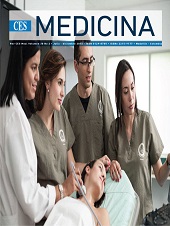Anatomical variations in the venous drainage of the neck
Abstract
The superficial veins, especially the external jugular vein are increasingly used for cannulation or diagnostic procedures, intravenous therapy, parenteral nutrition in debilitated patients. Variations in the venous drainage of the head and neck are important not only for anatomists and radiologists but also for surgeons. During routine dissection in the Laboratory of Morphology, University of Pamplona in a 75 year-old male cadaver in the region face and neck anatomical variations and unusual drainage patterns were found, which were dissected carefully and morphological details were photographed; these variations consisted of unilateral absence of external jugular vein. The lingual vein, the infrahyoid vein and the superior thyroid vein had transverse venous connections that drained into a venous arch located between the common carotid artery and the superior thyroid artery. This draining venous arch upward in the common facial vein and down into the internal jugular vein. Knowledge of the anatomical and morphological variations in the veins of the head and neck is essential to carry out successful surgical procedures in these regions.Downloads
References
Van Middelkoop M, Kolkman J, Van Ochten J, Bierma-Zeinstra SM, Koes BW. Risk factors for lower extremity injuries among male marathon runners. Scand J Med Sci Sports. Dec 2008;18(6):691-697.
Instituto, Ipsos, Marplan. Esporte na vida do brasileiro. In: Dossiê Esporte, Um estudo sobre o esporte na vida do brasileiro, 2ª Parte2006:61-88.
Koplan JP, Powell KE, Sikes RK, Shirley RW, Campbell CC. An epidemiologic study of the benefits and risks of running. JAMA. Dec 17 1982;248(23):3118-3121.
Williams PT. Relationship of distance run per week to coronary heart disease risk factors in 8283 male runners. The National Runners' Health Study. Arch Intern Med. Jan 1997;157(2):191-198.
Organization WH. Integrated manegement of cardiovascular risk. WHO meeting; Jully 9-12, 2002; Geneva.
Van Gent RN, Siem D, van Middelkoop M, van Os AG, Bierma-Zeinstra SM, Koes BW. Incidence and determinants of lower extremity running injuries in long distance runners: a systematic review. Br J Sports Med. Aug 2007;41(8):469-480.
Lopes AD, Costa LO, Saragiotto BT, Yamato TP, Adami F, Verhagen E. Musculoskeletal pain is prevalent among recreational runners who are about to compete: an observational study of 1049 runners. J Physiother. 2011;57(3):179-182.
Hespanhol Junior LC, Costa LO, Carvalho AC, Lopes AD. A description of training characteristics and its association with previous musculoskeletal injuries in recreational runners: a cross-sectional study. Rev Bras Fisioter. Feb 2012;16(1):46-53.
Hespanhol Junior LC. Lesões musculoesqueléticas em corredores e características do treinamento: descrições, associações e taxas de lesão. São Paulo: Programa de Mestrado em Fisioterapia, Univercidade Cidade de São Paulo; 2011.
Pileggi P, Gualano B, Souza M, et al. Incidência e fatores de risco de lesões osteomioarticulares em corredores: um estudo de coorte prospectivo. Rev Bras Educ Fís Esporte. Out-Dez 2010;24(4):453-462.
Visnes H, Bahr R. The evolution of eccentric training as treatment for patellar tendinopathy (jumper's knee): a critical review of exercise programmes. Br J Sports Med. Apr 2007;41(4):217-223.
Magnussen RA, Dunn WR, Thomson AB. Nonoperative treatment of midportion Achilles tendinopathy: a systematic review. Clin J Sport Med. Jan 2009;19(1):54-64.
Moen MH, Tol JL, Weir A, Steunebrink M, De Winter TC. Medial tibial stress syndrome: a critical review. Sports Med. 2009;39(7):523-546.
Craig DI. Medial tibial stress syndrome: evidence-based prevention. J Athl Train. May-Jun 2008;43(3):316-318.
McPoil TG, Martin RL, Cornwall MW, Wukich DK, Irrgang JJ, Godges JJ. Heel pain-plantar fasciitis: clinical practice guildelines linked to the international classification of function, disability, and health from the orthopaedic section of the American Physical Therapy Association. J Orthop Sports Phys Ther. Apr 2008;38(4):A1-A18.
Barton CJ, Webster KE, Menz HB. Evaluation of the scope and quality of systematic reviews on nonpharmacological conservative treatment for patellofemoral pain syndrome. J Orthop Sports Phys Ther. Sep 2008;38(9):529-541.
Cheung RT, Davis IS. Landing pattern modification to improve patellofemoral pain in runners: a case series. J Orthop Sports Phys Ther. Dec 2011;41(12):914-919.
Fredericson M, Wolf C. Iliotibial band syndrome in runners: innovations in treatment. Sports Med. 2005;35(5):451-459.
Jarvinen TA, Jarvinen TL, Kaariainen M, et al. Muscle injuries: optimising recovery. Best Pract Res Clin Rheumatol. Apr 2007;21(2):317-331.
Buist I, Bredeweg SW, Bessem B, van Mechelen W, Lemmink KA, Diercks RL. Incidence and risk factors of running-related injuries during preparation for a 4-mile recreational running event. Br J Sports Med. Jun 2010;44(8):598-604.
McBain K, Shrier I, Shultz R, et al. Prevention of sports injury I: a systematic review of applied biomechanics and physiology outcomes research. Br J Sports Med. Mar 2012;46(3):169-173.
Yeung SS, Yeung EW, Gillespie LD. Interventions for preventing lower limb soft-tissue running injuries. Cochrane Database Syst Rev. 2011(7):CD001256.
Richards CE, Magin PJ, Callister R. Is your prescription of distance running shoes evidence-based? Br J Sports Med. 2009;43(3):159-162.
Ryan MB, Valiant GA, McDonald K, Taunton JE. The effect of three different levels of footwear stability on pain outcomes in women runners: a randomised control trial. Br J Sports Med. Jul 2011;45(9):715-721.
Lieberman DE, Venkadesan M, Werbel WA, et al. Foot strike patterns and collision forces in habitually barefoot versus shod runners. Nature. Jan 2010;463(7280):531-535.
Logan S, Hunter I, Hopkins JT, Feland JB, Parcell AC. Ground reaction force differences between running shoes, racing flats, and distance spikes in runners. J Sports Sci Med. 2010;9(1):147-153.
Hasegawa H, Yamauchi T, Kraemer WJ. Foot strike patterns of runners at the 15-km point during an elite-level half marathon. J Strength Cond Res. Aug 2007;21(3):888-893.
Almeida MO. Distribuição e caracterização do padrão de aterrissagem do pé no solo em corredores. São Paulo: Programa de Mestrado em Fisioterapia, Universidade Cidade de São Paulo; 2012.
Daoud AI, Geissler GJ, Wang F, Saretsky J, Daoud YA, Lieberman DE. Foot Strike and Injury Rates in Endurance Runners: a retrospective study. Med Sci Sports Exerc. Jan 3 2012.
Downloads
Published
How to Cite
Issue
Section
License
Derechos de reproducción (copyright)
Cada manuscrito se acompañará de una declaración en la que se especifique que los materiales son inéditos, que no han sido publicados anteriormente en formato impreso o electrónico y que no se presentarán a ningún otro medio antes de conocer la decisión de la revista. En todo caso, cualquier publicación anterior, sea en forma impresa o electrónica, deberá darse a conocer a la redacción por escrito.
Plagios, duplicaciones totales o parciales, traduccones del original a otro idioma son de responsabilidad exclusiva de los autores el envío.
Los autores adjuntarán una declaración firmada indicando que, si el manuscrito se acepta para su publicación, los derechos de reproducción son propiedad exclusiva de la Revista CES Medicina.
Se solicita a los autores que proporcionen la información completa acerca de cualquier beca o subvención recibida de una entidad comercial u otro grupo con intereses privados, u otro organismo, para costear parcial o totalmente el trabajo en que se basa el artículo.
Los autores tienen la responsabilidad de obtener los permisos necesarios para reproducir cualquier material protegido por derechos de reproducción. El manuscrito se acompañará de la carta original que otorgue ese permiso y en ella debe especificarse con exactitud el número del cuadro o figura o el texto exacto que se citará y cómo se usará, así como la referencia bibliográfica completa.
| Article metrics | |
|---|---|
| Abstract views | |
| Galley vies | |
| PDF Views | |
| HTML views | |
| Other views | |



